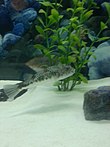
Brackish water, sometimes termed brack water, is water occurring in a natural environment that has more salinity than freshwater, but not as much as seawater. It may result from mixing seawater and fresh water together, as in estuaries, or it may occur in brackish fossil aquifers. The word comes from the Middle Dutch root brak. Certain human activities can produce brackish water, in particular civil engineering projects such as dikes and the flooding of coastal marshland to produce brackish water pools for freshwater prawn farming. Brackish water is also the primary waste product of the salinity gradient power process. Because brackish water is hostile to the growth of most terrestrial plant species, without appropriate management it is damaging to the environment.
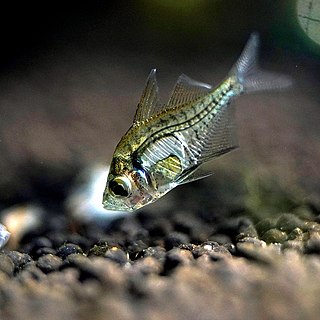
Parambassis ranga, commonly known as the Indian glassy fish, Indian glassy perch, or Indian X-ray fish, is a species of freshwater fish in the Asiatic glassfish family Ambassidae of order Perciformes. It is native to an area of South Asia from Pakistan to Malaysia and Bangladesh.
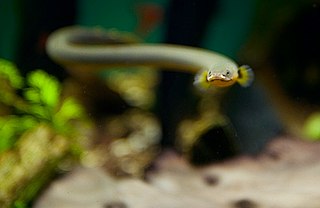
The reedfish, ropefish, or snakefish, Erpetoichthys calabaricus, is a species of fish in the bichir family and order. It is the only member of the genus Erpetoichthys. It is native to fresh and brackish waters in West and Central Africa. The reedfish possesses a pair of lungs in addition to gills, allowing it to survive in very oxygen-poor water. It is threatened by habitat loss through palm oil plantations, other agriculture, deforestation, and urban development.
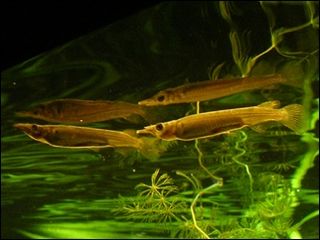
The wrestling halfbeak also known as Malayan halfbeak is a species of viviparous halfbeak native to the fresh and brackish waters of rivers and coastal regions in South-East Asia, in Singapore, Thailand, Indonesia, Thailand, Malaysia, Borneo and Sumatra. It is a small, slender, livebearing fish, with the elongated lower jaw characteristic of its family. The colour of this species varies, depending on where the specimen is found. It is the type species of the genus Dermogenys.

Fishkeeping is a popular hobby, practiced by aquarists, concerned with keeping fish in a home aquarium or garden pond. There is also a piscicultural fishkeeping industry, serving as a branch of agriculture.
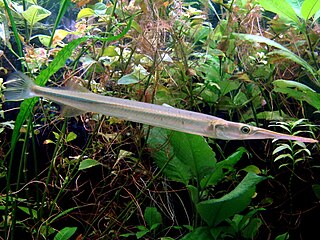
Xenentodon cancila, the freshwater garfish, is a species of needlefish found in freshwater and brackish habitats in South and Southeast Asia.

Dichotomyctere ocellatus, commonly the figure 8 puffer or eyespot puffer, is a pufferfish found in freshwater in Southeast Asia. It is known from the lower reaches of the Mekong (Cambodia), the Peninsular Malaysia as well as Borneo.
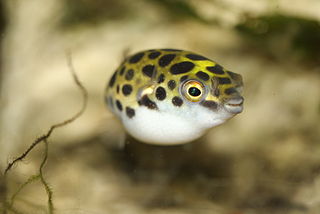
Dichotomyctere nigroviridis is one of the pufferfish known as the green spotted puffer. It is found across South and Southeast Asia in coastal freshwater,but survives the longest in brackish to saltwater, and brackish water habitats. D. nigroviridis reaches a typical maximum length of about 15 cm (6 in) (5.9 in), with reports of up to 17 cm (6.7 in). In February 2009, it was successfully bred in captivity at University of Florida using a new variation of the ovarian lavage technique.

The dwarf pufferfish, also known as the Malabar pufferfish, pygmy pufferfish, or pea pufferfish, is a small freshwater pufferfish endemic to Kerala and southern Karnataka in Southwest India. They are popular in aquaria for their bright colours and small size. At a maximum length of 3.5 cm, dwarf pufferfish are one of the smallest pufferfish in the world. They closely resemble the related Carinotetraodon imitator, and the two can be difficult to distinguish. C. imitator was not recognised as a different species until 1999.
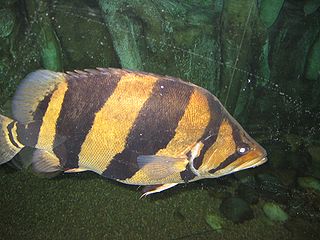
A brackish-water aquarium is an aquarium where the water is brackish (semi-salty). The range of "saltiness" varies greatly, from near freshwater to near marine and is often referred to as specific gravity (SG) or salinity. Brackish water aquaria is a popular specialization within the fishkeeping hobby. Many species of fish traded as freshwater species are actually true brackish species, for example mollies, Florida flagfish, and some cichlids such as chromides and black-chin tilapia. There are also several popular species traded purely as brackish water fish, including monos spp, scats, archerfish, and various species of pufferfish, goby, flatfish, and gar. Generally, aquarists need to maintain a specific gravity of around 1.005 to 1.010 depending on the species being kept, but practically all brackish water fish tolerate variations in salinity well, and some aquarists maintain that regularly fluctuating the salinity in the aquarium actually keeps the fish healthy and free of parasites.

Colomesus asellus, the Amazon puffer, asellus puffer, South American freshwater puffer or Peruvian puffer is a species of pufferfish confined to the Amazon, Essequibo and Orinoco basins in tropical South America. It is a popular aquarium species.

Carinotetraodon irrubesco, known commonly as the red-tail dwarf puffer, is a freshwater pufferfish found only in the lower Banyuasin basin in South Sumatra and the Sambas River in West Kalimantan.

Brachygobius is a small genus of gobies. They are popular aquarium fish where a number of species are sold as bumblebee gobies because their colours are similar to those of bumblebees.

Lists of aquarium life include lists of fish, amphibians, invertebrates and plants in freshwater, brackish and marine aquariums. In fishkeeping, suitable species of aquarium fish, plants and other organisms vary with the size, water chemistry and temperature of the aquarium. The lists include:

An aquarium is a vivarium of any size having at least one transparent side in which aquatic plants or animals are kept and displayed. Fishkeepers use aquaria to keep fish, invertebrates, amphibians, aquatic reptiles, such as turtles, and aquatic plants. The term aquarium, coined by English naturalist Philip Henry Gosse, combines the Latin root aqua, meaning 'water', with the suffix -arium, meaning 'a place for relating to'.
Brachygobius nunus, the Golden banded goby, is a species of bumblebee goby, a small genus of gobies that takes its common name from their round bodies, big heads, and their overall yellow to golden coloration interrupted by four brown to black vertical stripes reminiscent of the striped pattern of a bumblebee. They have also been figuratively described as "buzzing" from one surface to another inside the aquarium. Like other members of its genus, it is popular as an aquarium fish.
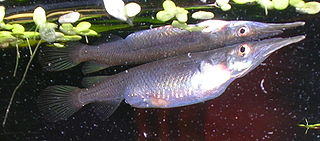
Zenarchopteridae, the viviparous halfbeaks, is a family in the order Beloniformes. The Zenarchopteridae exhibit strong sexual dimorphism, practicing internal fertilisation, and in some cases ovoviviparous or viviparous. The members in the family are mainly found in fresh and brackish water of tropical Asia and New Guinea, but the genus Zenarchopterus also includes marine species from the Indo-Pacific. Several, such as the wrestling halfbeak, have become commonly traded aquarium fish.
Heiko Bleher is a German researcher, author, photographer and filmmaker best known in the scientific community for his contribution to the exploration of fresh and brackish water habitats worldwide and the discovery of many species of fish and aquatic plants, several of which carry his name, discovery location or are named in honor of Bleher's family.





